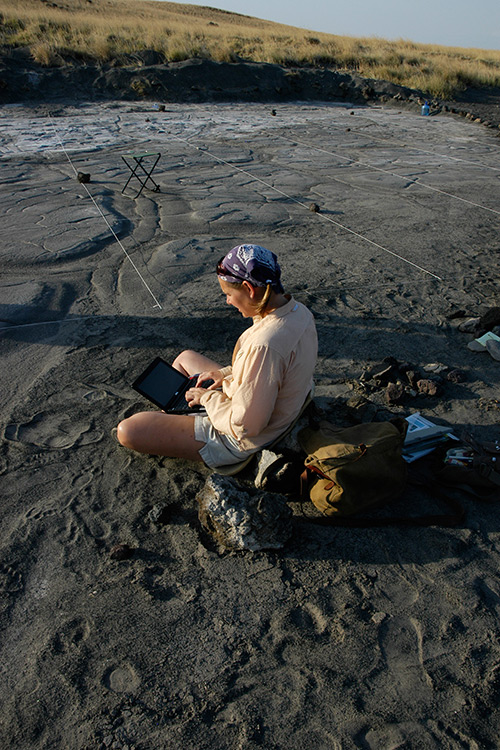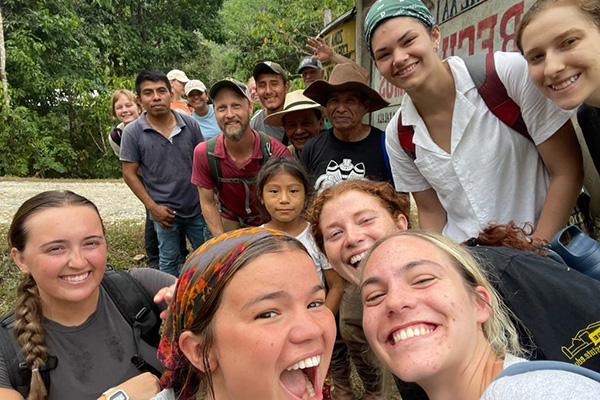BOONE—The spotlight is on Dr. Cynthia Liutkus-Pierce. Big time.
Her recently published research around the age and formation of the largest assemblage of Homo sapiens footprints discovered to date, in the shadow of the Ol Doinyo L’engai volcano in Tanzania, led to an Oct.10 article in National Geographic which prompted a feature on the front page of The Washington Post, and subsequent coverage by The Huffington Post, The Christian Science Monitor, Aussie Network News, and the British Broadcasting Company. The list goes on.
Liutkus-Pierce, an associate professor in the Department of Geology at Appalachian State University, said the attention is “exciting, overwhelming – but in the best way possible. So many of the people who have worked so hard on this project over the past several years are being rewarded for their efforts. And the interest in our research will be helpful as we continue.”
The data from the team’s research is now with the paleoanthropologists at the Smithsonian Institution and the American Museum of Natural History, who will explore what the prints can say about the printmakers. “I don’t want to scoop my colleagues,” Liutkus-Pierce said, “but the footprints tell us a great deal about the roots of human behavior – gender roles, movement patterns, what the people were doing and seeing… a true snapshot in time.”
The 400 or so footprints – which Liutkus-Pierce’s team of researchers have determined are between 19,000 and 10,000 years old – were actually discovered by a native from the nearby village of Engare Sero around 2006. World-renowned conservationist Jim Brett saw the prints when he was staying at a tented camp a few hundred yards from the footprints in 2008. Liutkus-Pierce said she had met Brett after he gave a lecture on African ecology at Bucknell University years prior, and told him then, “I love Africa and would love to get back there for research someday. If I can ever help, please give me a call.” Call he did, and in 2008, Liutkus-Pierce made her first trip to the site, returning in 2010 and 2011 with funding from the National Geographic Society and the Leakey Foundation. Her paper on the findings has been published in the journal Palaeogeography, Palaeoclimatology, Palaeoecology.
“Human origins is a huge interest of mine,” Liutkus-Pierce said. “I’ve always had an innate curiosity about who we are and what motivates us – maybe it was being the daughter of two psychologists,” she joked.
To that end, she studied moral and ethical philosophy at Bucknell University until, after meeting a dynamic and engaging geology professor during a study abroad semester at the University of Melbourne in Australia, she switched her major during second semester of her junior year. “My advisor said, ‘What, are you crazy?’” Crazy maybe, but she was following a passion – advice she gives her students as they make academic and career decisions. She not only completed her B.A. with a double major in geology and philosophy, but did it in four years, graduating cum laude.
In her office there are mementos of her travels: a poster about her research that features Tanzanian women walking in the ancient footprints – “the prints are my size, a seven,” and a portrait taken in the field – “You can tell I’m happy there,” a striking photo of the volcano and others of the Engare Sero natives.
Describing the terrain of the valley, Liutkus-Pierce seemed transported: “When you stand there [at the Tanzanian site] you can look south and see the volcano [Oldoinyo L’engai] looming and can imagine the lake [Lake Natron] at your back… It’s very arid and dry now, but there are nearby springs full of catfish and tilapia. The area is untouched and pristine, and so quiet – you can hear the doves cooing and the wildebeest lowing in the distance. The climate then [when the prints were made] would have been similar to now – hot, dusty and windy, but those springs would have provided water, food and shade just as they do now. It is a surreal place to work… you are busy at the site, looking down at the footprints, and you look up, over your shoulder, and see 60 or more zebra looking back at you.”
Liutkus-Pierce said the Tanzanian culture is extraordinarily welcoming and kind and, in her opinion, one our culture could learn from. “When you say ‘hello’ to someone, one of the first things they say is ‘karibu,’ which means ‘you are welcome’ – welcome to speak to me, welcome to engage. It is rude if you don’t ask ‘How are you? How is your family?’” she said.
A small obstacle on location was the reluctance on the part of the Tanzanians to accept a female as the leader, Liutkus-Pierce said. Her male colleagues were diligent in introducing her as the team leader and scientific director, she said “and eventually they accepted that I was in charge.”
Liutkus-Pierce’s research over the past decade was sandwiched between her work at Appalachian. She said teaching is truly her passion and she involves students in her research while encouraging them in theirs. She has supervised 16 undergraduate student research projects while at Appalachian, and has taken three undergraduates to Africa on research expeditions. She first came to Appalachian as an assistant professor in 2005. Boone and Appalachian, she said, was the perfect middle ground between Bucknell (approximately 3,000 students in rural Pennsylvania) and Rutgers, where she earned her M.Sc. and Ph.D. (more than 65,000 students in urban New Jersey.)
“I was really looking for a faculty position at a university that shared my commitment to teaching as well as scholarship, and Appalachian was a perfect fit,” she said. She and her husband have a farm in Wilkes County.
She served as one of five members of the proposal development team for Appalachian’s Quality Enhancement Plan and is an avid proponent of global learning. “There is no more ‘local only,’” she said. “This is a global society and we need to teach our students to be good global citizens. If there is a way you can do a study abroad experience, do it. When else will you get six months to immerse yourself in another culture?”
About the Department of Geology, College of Arts and Sciences
Located in Western North Carolina, Appalachian State University provides the perfect setting to study geology. The Department of Geology provides students with a solid foundation on which to build a successful career in the geosciences. The department offers both a B.A. and B.S. degree, with the option of concentrations in environmental geology, quantitative geoscience, paleontology and secondary education. Most students go into environmental consulting, mining, oil/gas or secondary education teaching (earth sciences or natural sciences), or enter graduate school.
The College of Arts & Sciences at Appalachian State University is home to 16 academic departments, three academic programs, two centers, and one residential college spanning the humanities, social sciences, and the mathematical and natural sciences. The college is dedicated to providing instruction and research essential to the University’s mission and seeks to cultivate the habits of inquiry, learning, and service among all its constituents.
About Appalachian State University
As a premier public institution, Appalachian State University prepares students to lead purposeful lives. App State is one of 17 campuses in the University of North Carolina System, with a national reputation for innovative teaching and opening access to a high-quality, cost-effective education. The university enrolls more than 21,000 students, has a low student-to-faculty ratio and offers more than 150 undergraduate and 80 graduate majors at its Boone and Hickory campuses and through App State Online. Learn more at https://www.appstate.edu.
What do you think?
Share your feedback on this story.


















